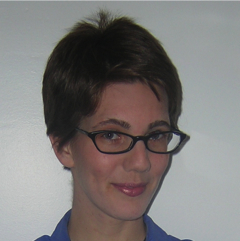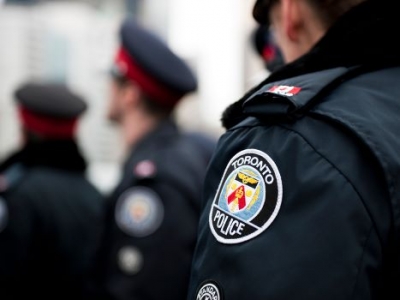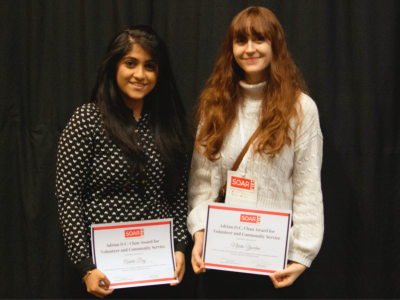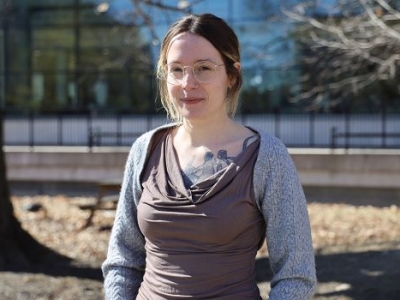After graduating with an undergrad degree in biology, Emma Peacocke decided to volunteer with the Sea Turtle Protection Society of Greece.
“And that’s where I found Lord Byron,” says Peacocke. “There were statues and mentions of him everywhere, as he was a major figure in the Greek War of Independence and died in Greece in 1824, so I began re-reading his work, and knew exactly what I wanted to do next.”
Peacocke came to Carleton to pursue a master’s degree with the Department of English Language and Literature. She is now a PhD candidate. Her thesis investigates museum-going as a vital part of British Romantic literature and culture.
Once she started thinking about proto-museums and museum-like settings, Peacocke says she was seeing them everywhere in Romantic Literature.
In Jane Austen’s Pride and Prejudice: “Elizabeth and Darcy’s relationship rather hinges on public museums. Their courtship finally starts to shed its awkwardness and combativeness when they meet unexpectedly at his stately home. Elizabeth is only able to be there because Pemberley is open to visitors, as many stately homes were from the 1790s on. They were precursors to museums and art galleries as we know them today.”
In Frances Burney’s The Wanderer: “The heroine is on the run, and she is so terrified of kidnappers that she doesn’t even recognize Stonehenge when she sees it. The only moment when she is genuinely free of anxiety comes when she is entranced by the sight of a painting in a stately home, Wilton, which admits visitors. That was a very telling moment, because we’re used to the idea that the Romantics worshipped nature and admired ruins – so for nature and ruins to exert less power to soothe than a painting made me sit up and take notice.”
In Keats’s sonnet called To Haydon [about his friend and artist Benjamin Robert Haydon]: “Apparently Haydon was baffled and a bit annoyed that Keats didn’t utter a word when they went to visit the Parthenon Marbles [sculptures in the British Museum] together in 1817 – so Keats had to write to explain that it was the sheer astonishment and rapture of seeing them that had silenced him.”
 Peacocke’s research also looks at the importance of museums, as institutions, during the Romantic period. She explains that a lot of changes in museums and display came from a direct reaction to the French Revolution, which began the Romantic Period. “Because the British constitutional monarchy needed to demonstrate its superiority to French republicanism, the Louvre’s opening in 1793 prompted British aristocrats to open their collections to the public (like at Pemberley) and the state to increase its museum activity. It is as if all of Britain came to an agreement that museums would serve as a metaphor for how the nation thought of itself, at home and in relation to its arch-enemy.”
Peacocke’s research also looks at the importance of museums, as institutions, during the Romantic period. She explains that a lot of changes in museums and display came from a direct reaction to the French Revolution, which began the Romantic Period. “Because the British constitutional monarchy needed to demonstrate its superiority to French republicanism, the Louvre’s opening in 1793 prompted British aristocrats to open their collections to the public (like at Pemberley) and the state to increase its museum activity. It is as if all of Britain came to an agreement that museums would serve as a metaphor for how the nation thought of itself, at home and in relation to its arch-enemy.”
So those who think of museums as just containing dusty old relics, Peacocke says: “They aren’t just missing the party – they’re missing the revolution as well.”
Peacocke hopes to graduate from Carleton in the near future. Reflecting on her time here, she says she is quite delighted with her experience. “There is such a rich array of talent at Carleton. Among other things, I’ve had a fantastic gig as a research assistant to a prominent Renaissance scholar, Chancellor’s Professor Donald Beecher. I learned a great deal about the era and really honed my bibliographic and research skills. We’ve also had an excellent visiting speakers’ program. And my thesis advisor, Prof. Julie Murray, is a brilliant scholar, with an encyclopaedic knowledge of 18th-century literature and up-to-the-minute knowledge of developments in literary criticism.”
Says Peacocke: “Graduating is going to be a wrench, but I know I’ll always be welcome at Carleton and I’ll never have to leave it behind completely.”




